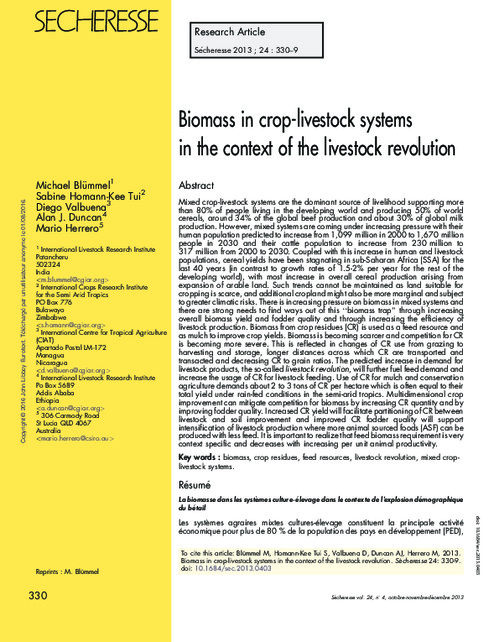Biomass in crop-livestock systems in the context of the livestock revolution
Abstract
Mixed crop-livestock systems are the dominant source of livelihood supporting more
than 80% of people living in the developing world and producing 50% of world
cereals, around 34% of the global beef production and about 30% of global milk
production. However, mixed systems are coming under increasing pressure with their
human population predicted to increase from 1,099 million in 2000 to 1,670 million
people in 2030 and their cattle population to increase from 230 million to
317 million from 2000 to 2030. Coupled with this increase in human and livestock
populations, cereal yields have been stagnating in sub-Saharan Africa (SSA) for the
last 40 years (in contrast to growth rates of 1.5-2% per year for the rest of the
developing world), with most increase in overall cereal production arising from
expansion of arable land. Such trends cannot be maintained as land suitable for
cropping is scarce, and additional cropland might also be more marginal and subject
to greater climatic risks. There is increasing pressure on biomass in mixed systems and
there are strong needs to find ways out of this ‘‘biomass trap’’ through increasing
overall biomass yield and fodder quality and through increasing the efficiency of
livestock production. Biomass from crop residues (CR) is used as a feed resource and
as mulch to improve crop yields. Biomass is becoming scarcer and competition for CR
is becoming more severe. This is reflected in changes of CR use from grazing to
harvesting and storage, longer distances across which CR are transported and
transacted and decreasing CR to grain ratios. The predicted increase in demand for
livestock products, the so-called livestock revolution, will further fuel feed demand and
increase the usage of CR for livestock feeding. Use of CR for mulch and conservation
agriculture demands about 2 to 3 tons of CR per hectare which is often equal to their
total yield under rain-fed conditions in the semi-arid tropics. Multidimensional crop
improvement can mitigate competition for biomass by increasing CR quantity and by
improving fodder quality. Increased CR yield will facilitate partitioning of CR between
livestock and soil improvement and improved CR fodder quality will support
intensification of livestock production where more animal sourced foods (ASF) can be
produced with less feed. It is important to realize that feed biomass requirement is very
context specific and decreases with increasing per unit animal productivity

